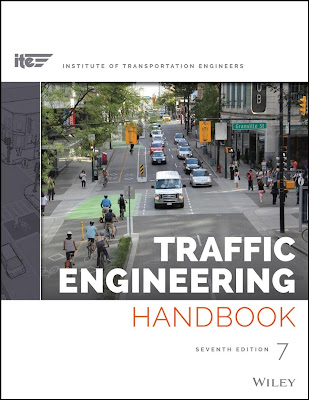Traffic Engineering Handbook 7th Edition
ITE., Pande,
Traffic engineering is the subdiscipline of transportation engineering that addresses the planning, design, and operation of streets and highways, their networks, adjacent lands, and interaction with other modes of transportation (air, water, and rail) and their terminals. Over many decades, the Institute of Transportation Engineers (ITE) has provided traffic engineering professionals with a comprehensive resource of fundamental traffic engineering concepts, as well as state-of-the-art practices, through the Traffic Engineering Handbook (TEH or Handbook). The Handbook's prior editions have been widely used by public agencies, consultants, and educational institutions as a basic day-to-day reference source on the proven techniques of the practice. The primary audience for this publication is practicing professionals responsible for the safe and efficient operation of the roadway transportation networks. The secondary audience includes academia in general and educators in particular. The Handbook can also be used as a reference by the general public and policymakers, but it is not written primarily for that audience.

Size: 30 MB
Download
*
ITE., Pande,
Traffic engineering is the subdiscipline of transportation engineering that addresses the planning, design, and operation of streets and highways, their networks, adjacent lands, and interaction with other modes of transportation (air, water, and rail) and their terminals. Over many decades, the Institute of Transportation Engineers (ITE) has provided traffic engineering professionals with a comprehensive resource of fundamental traffic engineering concepts, as well as state-of-the-art practices, through the Traffic Engineering Handbook (TEH or Handbook). The Handbook's prior editions have been widely used by public agencies, consultants, and educational institutions as a basic day-to-day reference source on the proven techniques of the practice. The primary audience for this publication is practicing professionals responsible for the safe and efficient operation of the roadway transportation networks. The secondary audience includes academia in general and educators in particular. The Handbook can also be used as a reference by the general public and policymakers, but it is not written primarily for that audience.

Code:
- Introduction To The Traffic Engineering Handbook And Its Role In Evolving Practice
- Probability And Statistical Analyses Techniques For Traffic Engineering Performance Measurement
- Road Users
- Traffic Engineering Studies
- Level Of Service Concepts In Multimodal Environments
- Forecasting Travel Demand
- Traffic Flow Characteristics For Uninterrupted Flow Facilities
- Design And Operations Of Road Segments And Interchanges In Rural Areas
- Planning, Design, And Operations Of Road Segments And Interchanges In Urban Areas
- Design And Control For Interrupted Traffic Flow Through Intersections
- Design And Operation Of Complete Streets And Intersections
- Access Management
- Parking
- Traffic Calming
- Work Zone Maintenance Of Traffic And Construction Staging
- Traffic Management For Planned, Unplanned, And Emergency Events
Size: 30 MB
Download
*
